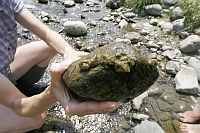 (Host) An invasive algae found last summer in several Vermont rivers appears not to have spread to other streams around the state.
(Host) An invasive algae found last summer in several Vermont rivers appears not to have spread to other streams around the state.
But state officials are still concerned. They say that anglers and other people who travel from river to river should take precautions to contain the outbreak.
VPR’s John Dillon reports.
(Dillon) The algae is called didymo. It spreads aggressively, forming thick slimy mats that can coat every rock on the stream bottom.
Besides its disgusting appearance, the concern is that didymo can smother stream habitat, and damage fish populations.
Last summer, scientists confirmed didymo in the White, Connecticut and Battenkill Rivers. So far, that’s apparently where it remains in Vermont.
Leslie Matthews is a staff scientist with the Vermont Department of Environmental Conservation.
(Matthews) "Areas that we saw nuisance blooms occurring last year have come back this year. And it’s pretty extensive. But as far as spreading to other rivers around the state, we don’t have any evidence of that yet."
(Dillon) Matthews says it’s hard to prove a negative, so officials aren’t absolutely sure didymo hasn’t spread. She says the state simply doesn’t have the resources to check every stream.
But the public has been out looking as well, says Michael Humling, a state fisheries biologist.
(Humling) "We’ve received quite a few calls saying, ‘ hey I think I might have seen didymo,’ when in fact when they send a sample in or someone goes out to look at it, it turns out to be not. So kind of this general algae awareness has risen, which has been good. But fortunately, a lot of those sightings have been indeed not didymo"
(Dillon) The public is also more aware of the precautions that should be taken to prevent its spread. River users should disinfect their gear before going to another body of water.
Anglers are also encouraged to find alternatives to felt soled waders. The felt provides a firm grip on rocks, but it’s spongy and provides an ideal medium to transfer the organism from stream to stream.
Not much is known about why didymo is spreading around the world. Bob Genter is a biology professor at Johnson State College who did graduate research in algae.
He says didymo is a diatom, a type of algae that is normally a good food source for the bugs and other organisms that live in streams.
(Genter1 0619) "But when you see something like this that grows that that thick, either it’s growing faster than it’s being eaten or it’s not as palatable. … It’s caught the scientific community by surprise."
(Dillon) Last October, Genter looked for didymo in 20 streams around the state. He didn’t find it, but he questions whether it was too late in the year. He hopes to continue the search again this summer.
For VPR News, I’m John Dillon in Montpelier.
AP Photo/Toby Talbot